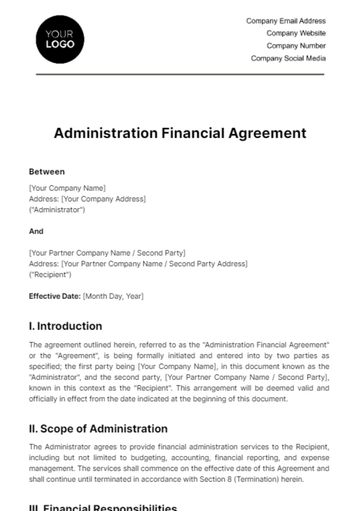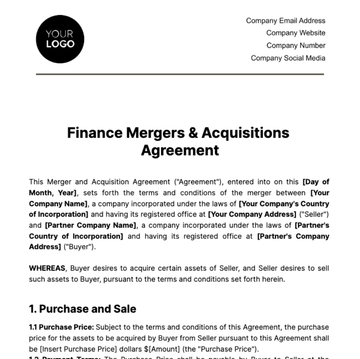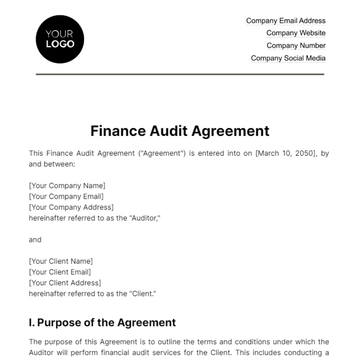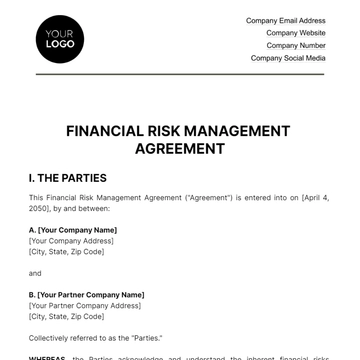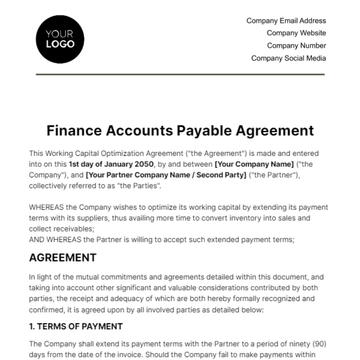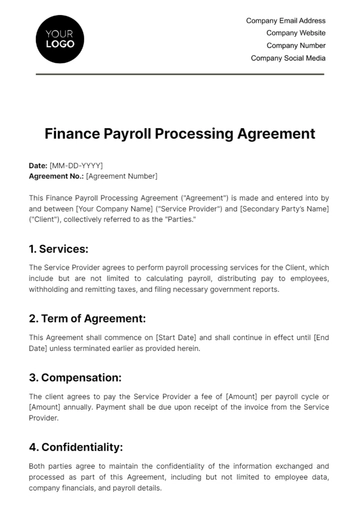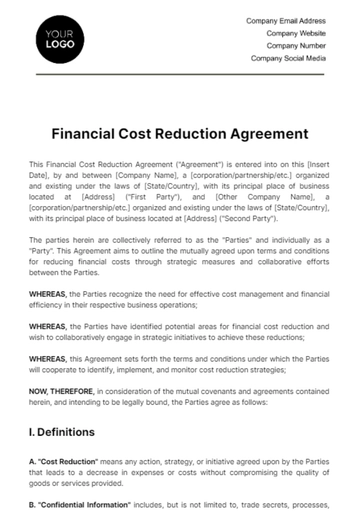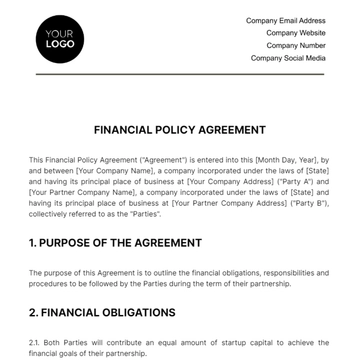Free Financial Cost Reduction Agreement
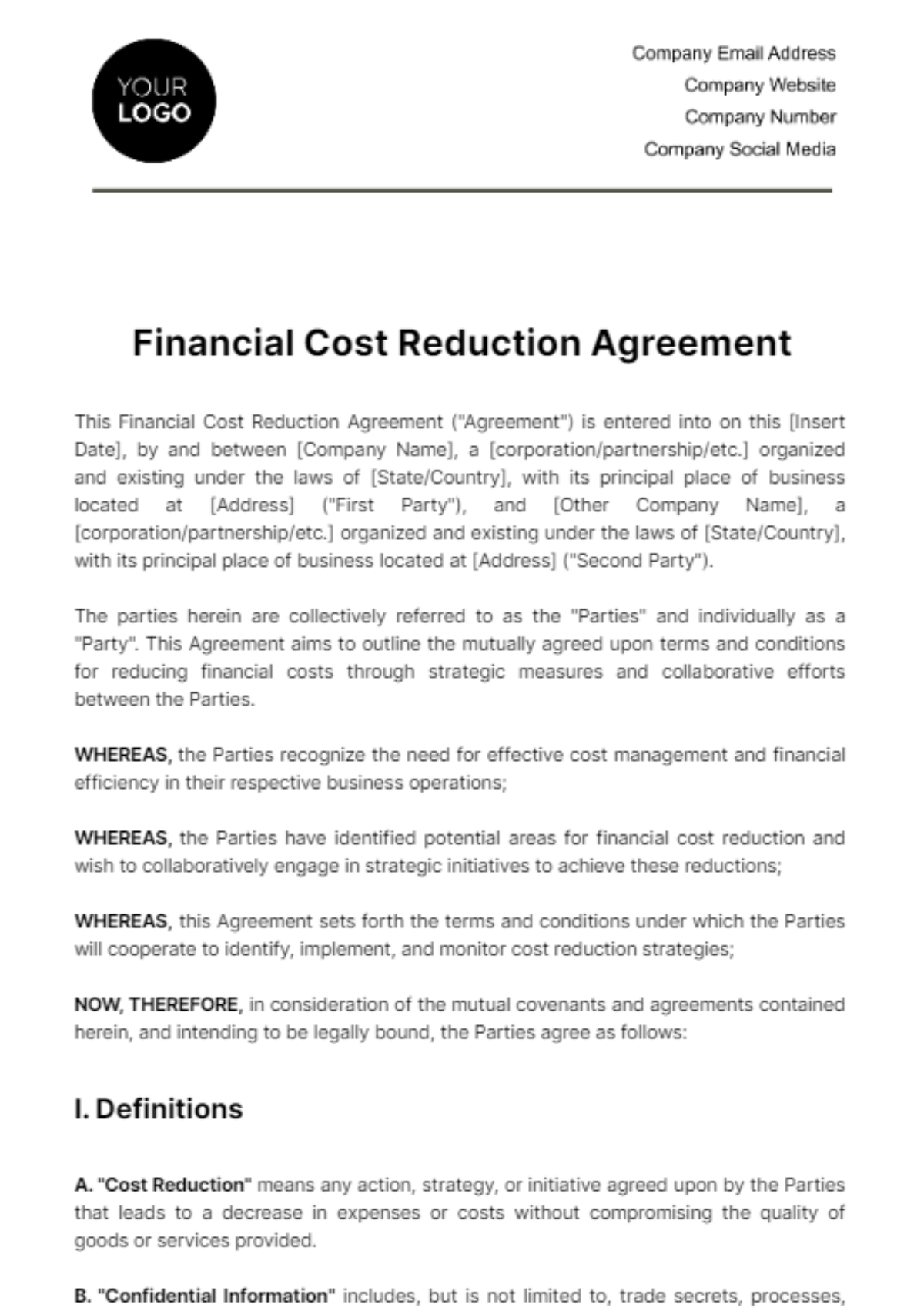
This Financial Cost Reduction Agreement ("Agreement") is entered into on this [Insert Date], by and between [Company Name], a [corporation/partnership/etc.] organized and existing under the laws of [State/Country], with its principal place of business located at [Address] ("First Party"), and [Other Company Name], a [corporation/partnership/etc.] organized and existing under the laws of [State/Country], with its principal place of business located at [Address] ("Second Party").
The parties herein are collectively referred to as the "Parties" and individually as a "Party". This Agreement aims to outline the mutually agreed upon terms and conditions for reducing financial costs through strategic measures and collaborative efforts between the Parties.
WHEREAS, the Parties recognize the need for effective cost management and financial efficiency in their respective business operations;
WHEREAS, the Parties have identified potential areas for financial cost reduction and wish to collaboratively engage in strategic initiatives to achieve these reductions;
WHEREAS, this Agreement sets forth the terms and conditions under which the Parties will cooperate to identify, implement, and monitor cost reduction strategies;
NOW, THEREFORE, in consideration of the mutual covenants and agreements contained herein, and intending to be legally bound, the Parties agree as follows:
I. Definitions
A. "Cost Reduction" means any action, strategy, or initiative agreed upon by the Parties that leads to a decrease in expenses or costs without compromising the quality of goods or services provided.
B. "Confidential Information" includes, but is not limited to, trade secrets, processes, formulas, data, know-how, improvements, inventions, techniques, marketing plans, strategies, forecasts, and financial information disclosed between the Parties.
II. Objectives of Cost Reduction
A. Overall Goal: The primary aim of this Agreement is to collaboratively work towards a sustainable reduction in operational and administrative costs. In achieving this goal, the Parties are committed to maintaining, if not enhancing, the quality and efficiency of the services or products they provide.
B. Specific Targets:
Operational Expense Reduction: The Parties aim to reduce overall operational expenses by 15% within the next 12 months. This target is set to encourage focused efforts on cost efficiency.
Cost-Saving Measures Implementation: Key areas such as supply chain management, energy consumption, and staffing efficiencies will be targeted for identifying and implementing cost-saving measures. These areas represent significant opportunities for reducing expenses without compromising service or product quality.
Procurement Strategy Enhancement: A minimum cost reduction of 10% in procurement expenses is targeted. This involves revising current procurement strategies to achieve more economical outcomes.
C. Scope and Focus Areas:
Operational Efficiency: The Parties will focus on streamlining processes to eliminate waste and reduce operational costs. This includes evaluating current workflows and identifying areas where efficiency can be improved.
Procurement and Supply Chain Management: Negotiating better terms with suppliers and optimizing the supply chain are key focus areas. This involves a comprehensive review of existing contracts and supply chain operations to identify cost-saving opportunities.
Energy Consumption: Implementing energy-saving initiatives to minimize utility costs will be pursued. This may include transitioning to more energy-efficient technologies and practices.
Technology Utilization: The Parties will leverage technology to automate and optimize operations, thus reducing costs. This includes exploring new technological solutions that can enhance operational efficiency and reduce manual labor costs.
III. Roles and Responsibilities
A. First Party Responsibilities:
Conduct a comprehensive review of current operational processes and identify areas for cost reduction.
Lead the implementation of technology-based solutions to optimize efficiency.
Provide regular progress reports to the Second Party on the status of cost reduction initiatives.
B. Second Party Responsibilities:
Oversee the analysis of procurement strategies and negotiate with suppliers for better rates and terms.
Implement and monitor energy-saving measures across all operations.
Collaborate with the First Party in developing and executing the Implementation Plan.
C. Joint Responsibilities:
Establish a joint committee to oversee and guide the cost reduction initiatives.
Share relevant data and information to facilitate informed decision-making.
Regularly review and adjust strategies as needed to meet the set targets.
D. Accountability Mechanisms: The joint committee will meet quarterly to review progress against targets. Each Party will designate a representative responsible for providing updates and addressing issues related to the Agreement. In the event of not meeting the agreed-upon targets, both Parties will engage in a review process to identify obstacles and revise strategies accordingly.
IV. Cost Reduction Strategies and Methods
A. Strategies for Cost Reduction:
Process Reengineering: The Parties will undertake an analysis of existing business processes to identify inefficiencies. The objective is to re-engineer these processes to streamline operations and reduce costs.
Supply Chain Optimization: By reassessing current supply chain operations, the Parties aim to enhance efficiency and cut costs. This may include renegotiating supplier contracts, consolidating orders, and optimizing logistics.
Energy Management: Implementing energy-efficient practices and technologies will be a key strategy. This will involve auditing current energy usage and investing in cost-effective solutions to reduce utility expenses.
Technology and Automation: Where feasible, the Parties will introduce automation and advanced technology solutions to reduce manual processes, thereby saving time and reducing labor costs.
B. Methods of Implementation:
Benchmarking and Best Practices: The Parties will benchmark their operations against industry best practices to identify areas for improvement.
Regular Cost-Benefit Analyses: For each proposed cost reduction measure, a cost-benefit analysis will be performed to ensure that the benefits outweigh the costs.
Employee Engagement and Training: Employees will be engaged and trained in cost-reduction practices to foster a culture of efficiency and cost-consciousness.
C. Criteria for Method Selection:
Effectiveness and Impact: The potential impact on reducing costs without compromising quality or service.
Feasibility and implementability: The practicality of implementing the methods within the given resources and timeframes.
Sustainability: Ensuring that cost reduction methods are sustainable in the long term and do not adversely affect the business in the future.
Compliance with Regulations: All methods must comply with relevant laws, regulations, and industry standards to avoid legal and ethical issues.
V. Implementation Plan
A. Initial Assessment and Planning:
Conduct a full audit of current expenses and operations (Month 1).
Develop a detailed plan based on the strategies and methods agreed upon (Month 2).
B. Execution Phase:
Begin implementation of process optimization and technology integration initiatives (Months 3-6).
Initiate supplier negotiations and order consolidation (Month 4).
Launch energy efficiency improvements (Month 5).
C. Monitoring and Adjustment:
Regularly review the progress of each initiative and adjust strategies as needed (Monthly from Month 7).
Quarterly evaluation against benchmarks and ROI targets.
D. Milestones:
Completion of the initial audit and planning phase (End of Month 2).
Achievement of the first phase of cost reductions (End of Month 6).
Review and adjustment of strategies (End of Month 9).
Final evaluation and report on the effectiveness of the cost reduction plan (End of Year 1).
VI. Monitoring and Reporting
A. Monitoring Framework: A structured monitoring framework will be established to oversee the implementation and progress of the cost reduction strategies. This will include setting up a joint monitoring committee comprising representatives from both Parties, responsible for tracking progress, assessing the effectiveness of initiatives, and ensuring alignment with the agreed objectives.
B. Key Performance Indicators (KPIs): Specific Key Performance Indicators (KPIs) will be defined to measure the success of cost reduction efforts. These KPIs will include metrics such as percentage reduction in operational costs, efficiency improvements, and ROI on cost-saving measures.
C. Regular Progress Reviews: The joint monitoring committee will conduct regular progress review meetings every quarter. During these meetings, the implementation of strategies, achievement of KPIs, and any challenges or bottlenecks will be discussed.
D. Reporting Requirements: Detailed progress reports will be prepared by the monitoring committee after each review meeting. These reports will outline the status of cost reduction efforts, KPI achievements, and any recommended adjustments to strategies. The First Party will be responsible for consolidating these progress reports and presenting them to the Second Party.
E. Transparency and Communication: Both Parties commit to maintaining a high level of transparency throughout the monitoring process. All relevant data and findings will be openly shared between the Parties. Regular communication channels will be established to ensure ongoing collaboration and timely resolution of any issues that arise during the implementation phase.
F. Annual Performance Evaluation: An annual performance evaluation will be conducted to assess the overall effectiveness of the cost reduction initiatives. This evaluation will include a comprehensive review of the year’s progress, an analysis of the achievement of KPIs, and recommendations for future improvements.
VII. Financial Provisions
A. Budget Allocation and Management: The Parties agree to allocate a dedicated budget specifically for the implementation of the cost reduction initiatives outlined in this Agreement. The budget allocation shall be 5% of the total project cost, with each Party contributing 50%.
B. Financial Contributions and Cost Sharing: Financial contributions for the initiatives under this Agreement shall be shared between the Parties. The First Party shall contribute 50%, and the Second Party shall contribute 50%. These contributions are subject to adjustment based on the actual cost incurred during the implementation phase.
C. Management of Funds: A joint account will be established for managing the funds allocated for the cost reduction initiatives. Both Parties will have equal access and authority to review and audit the account to ensure transparency and accountability.
D. Reporting and Auditing of Financials: Regular financial reporting is required to track the expenditure and effectiveness of the allocated budget. The Parties shall provide financial reports every quarter, which will include detailed accounting of all expenses. An annual audit of the financials related to this Agreement will be conducted by an independent auditor agreed upon by both Parties, ensuring adherence to the agreed financial provisions and transparency.
E. Return on Investment (ROI) and Savings Distribution: The Parties agree to calculate the Return on Investment (ROI) for the cost reduction initiatives annually. Any savings achieved beyond the expected ROI will be distributed between the Parties in proportion to their initial financial contributions.
F. Revision of Financial Terms: The financial terms of this Agreement may be revisited and revised by mutual consent of the Parties if there is a significant change in the scope or scale of the cost reduction initiatives. Such revisions must be documented in writing and signed by both Parties.
VIII. Confidentiality Clause
A. Obligation of Confidentiality: Both Parties agree to maintain the confidentiality of all information shared or generated about this Agreement. This includes, but is not limited to, financial data, strategies, and any documents produced.
B. Use of Confidential Information: Confidential information shall only be used for fulfilling obligations under this Agreement and not for any other purpose.
C. Duration of Confidentiality: The confidentiality obligations shall remain in effect for five years following the termination or conclusion of this Agreement.
D. Exceptions to Confidentiality: Information that is publicly known or becomes publicly known through no fault of either Party is not considered confidential.
IX. Compliance and Legal Considerations
A. Adherence to Laws and Regulations: Both Parties commit to comply with all applicable laws and regulations in the execution of this Agreement, including but not limited to financial regulations, data protection laws, and industry standards.
B. Legal Disputes: In the event of a legal dispute arising from this Agreement, the Parties agree to seek resolution through mediation before pursuing litigation. Any legal proceedings related to this Agreement shall be conducted in the jurisdiction of the State of New York, United States.
C. Amendments and Modifications: Any amendments or modifications to this Agreement must be made in writing and signed by both Parties.
D. Severability: If any provision of this Agreement is found to be invalid or unenforceable, the remaining provisions will continue to be valid and enforceable.
X. Amendment and Termination
A. Amendment: This Agreement may be amended only by a written document duly executed by both Parties. Any such amendments will become effective as of the date stated in the amendment document.
B. Termination: Either Party may terminate this Agreement upon 60 days’ written notice to the other Party. Termination can occur in the event of a material breach of the Agreement terms, provided the breaching Party is allowed to cure the breach within a specified period. Upon termination, each Party must return or destroy any confidential information received from the other Party.
XI. Force Majeure
A. Definition: "Force Majeure" refers to any event beyond the reasonable control of the Parties, including but not limited to natural disasters, wars, terrorist acts, government actions, pandemics, or labor strikes.
B. Effect of Force Majeure: If either Party is unable to perform its obligations under this Agreement due to a Force Majeure event, such non-performance shall not be considered a breach of this Agreement. The affected Party must notify the other Party promptly, detailing the nature and expected duration of the Force Majeure event. Obligations under the Agreement will be suspended for the duration of the Force Majeure event.
IN WITNESS WHEREOF, the Parties hereto have executed this Financial Cost Reduction Agreement as of the Effective Date.
First Party
[Signature]
[Name]
[Title]
[Date]
Second Party
[Signature]
[Name]
[Title]
[Date]
- 100% Customizable, free editor
- Access 1 Million+ Templates, photo’s & graphics
- Download or share as a template
- Click and replace photos, graphics, text, backgrounds
- Resize, crop, AI write & more
- Access advanced editor
Financial Cost Reduction Agreement Template from Template.net is your essential tool for businesses focused on negotiating and formalizing cost-cutting measures. Fully editable and customizable in our AI tool, this template simplifies drafting agreements, ensuring clarity and precision in outlining terms. Designed to meet diverse financial scenarios, it offers flexibility and ease, making it indispensable for efficient financial management.
You may also like
- Lease Agreement
- Non Compete Agreement
- Rental Agreement
- Prenuptial Agreement
- Non Disclosure Agreement
- Operating Agreement
- Hold Harmless Agreement
- LLC Operating Agreement
- Arbitration Agreement
- Purchase Agreement
- Residential Lease Agreement
- Executive Agreement
- Confidentiality Agreement
- Contractor Agreement
- Partnership Agreement
- Postnuptial Agreement
- Collective Bargaining Agreement
- Loan Agreement
- Roommate Agreement
- Commercial Lease Agreement
- Separation Agreement
- Cohabitation Agreement
- Room Rental Agreement
- Child Custody Agreement
- Employee Agreement
- License Agreements
- Settlement Agreement
- Joint Venture Agreement
- Indemnity Agreement
- Subordination Agreement
- Sales Agreement
- Agreements Between Two Parties
- Business Agreement
- Real Estate Agreement
- HR Agreement
- Service Agreement
- Property Agreement
- Agreement Letter
- Restaurant Agreement
- Construction Agreement
- Finance Agreement
- Marketing Agreement
- Payment Agreement
- Investment Agreement
- Management Agreement
- Nonprofit Agreement
- Software Agreement
- Startup Agreement
- Agency Agreement
- Copyright Agreement
- Collaboration Agreement
- Reseller Agreement
- Car Rental Agreement
- Cleaning Services Agreement
- Consultant Agreement
- Deed Agreement
- Car Agreement
- Equipment Agreement
- Shares Agreement
- Data Sharing Agreement
- Advertising Agreement
- School Agreement
- Franchise Agreement
- Event Agreement
- Travel Agency Agreement
- Vehicle Agreement
- Board Resolution Agreement
- Land Agreement
- Binding Agreement
- Tenancy Agreement
- Exclusive Agreement
- Development Agreement
- Assignment Agreement
- Design Agreement
- Equity Agreement
- Mortgage Agreement
- Purchase and Sale Agreement
- Shareholder Agreement
- Vendor Agreement
- Royalty Agreement
- Vehicle Lease Agreement
- Hotel Agreement
- Tenant Agreement
- Artist Agreement
- Commission Agreement
- Consignment Agreement
- Debt Agreement
- Recruitment Agreement
- Training Agreement
- Transfer Agreement
- Apprenticeship Agreement
- IT and Software Agreement
- Referral Agreement
- Resolution Agreement
- Waiver Agreement
- Consent Agreement
- Partner Agreement
- Social Media Agreement
- Customer Agreement
- Credit Agreement
- Supply Agreement
- Agent Agreement
- Brand Agreement
- Law Firm Agreement
- Maintenance Agreement
- Mutual Agreement
- Retail Agreement
- Deposit Agreement
- Land Purchase Agreement
- Nursing Home Agreement
- Supplier Agreement
- Buy Sell Agreement
- Child Support Agreement
- Landlord Agreement
- Payment Plan Agreement
- Release Agreement
- Research Agreement
- Sponsorship Agreement
- Buyout Agreement
- Equipment Rental Agreement
- Farm Agreement
- Manufacturing Agreement
- Strategic Agreement
- Termination of Lease Agreement
- Compliance Agreement
- Family Agreement
- Interior Design Agreement
- Ownership Agreement
- Residential Lease Agreement
- Retainer Agreement
- Trade Agreement
- University Agreement
- Broker Agreement
- Dissolution Agreement
- Funding Agreement
- Hosting Agreement
- Investor Agreement
- Memorandum of Agreement
- Advisory Agreement
- Affiliate Agreement
- Freelancer Agreement
- Grant Agreement
- Master Service Agreement
- Parking Agreement
- Subscription Agreement
- Trust Agreement
- Cancellation Agreement
- Horse Agreement
- Influencer Agreement
- Membership Agreement
- Vacation Rental Agreement
- Wholesale Agreement
- Author Agreement
- Distributor Agreement
- Exchange Agreement
- Food Agreement
- Guarantee Agreement
- Installment Agreement
- Internship Agreement
- Music Agreement
- Severance Agreement
- Software Development Agreement
- Storage Agreement
- Facility Agreement
- Intercompany Agreement
- Lending Agreement
- Lodger Agreement
- Outsourcing Services Agreement
- Usage Agreement
- Assurance Agreement
- Photography Agreement
- Profit Sharing Agreement
- Relationship Agreement
- Rent To Own Agreement
- Repayment Agreement
- Volunteer Agreement
- Co Parenting Agreement
- HVAC Agreement
- Lawn Care Agreement
- SAAS Agreement
- Work from Home Agreement
- Coaching Agreement
- Protection Agreement
- Security Agreement
- Repair Agreement
- Agreements License

